TweakTown’s Rating: 94%

The Bottom Line
AORUS has a winner with the 17X, a legit desktop replacement that offers class-leading performance and connectivity to go with it!
Pros
- + Intel 14900HX and GeForce RTX 4090
- + DDR5 SO-DIMM and Dual Gen4 NVMe
- + Performance
- + 2.5Gbe LAN and Thunderbolt 4
- + 1440p 240Hz G-Sync panel
Cons
- – Factory NVMe solution could be better
- – Wi-Fi 6E
- – Expensive
Should you buy it?
AvoidConsiderShortlistBuy
Introduction, Specifications, and Pricing
We have been waiting for the 17X after our fantastic experience with the 16X earlier this month. As the flagship gaming laptop from AORUS, it features top-of-the-line hardware, including the Intel Raptor Lake 14900HX and NVIDIA’s monstrous GeForce RTX 4090 laptop GPU. On top of this, we have an all-out display with a 1440p resolution, 240Hz refresh rate, and certifications like 100% DCI-P3 along with Dolby Vision HDR. It even takes advantage of NVIDIA G-Sync for smooth frames when gaming.
Further into the hardware, the 17X has just a single CPU choice from the Raptor Lake lineup: the 14900HX; this gives consumers eight performance cores and sixteen efficient cores for twenty-four cores and with hyper-threading enabled thirty-two threads. Base clocks come in at 1.6GHz for the e-cores and 2.2 GHz for the P-cores, while turbo clocks reach 4.1GHz for the E-cores and 5.8GHz for the p-cores. Memory support is over two DDR5 SO-DIMM slots; Our 17X was outfitted with 32GB of 5600MHz out of the box. Of course, we have the RTX 4090 from NVIDIA with 16GB of dedicated VRAM and TDP @ 120W. This powers the 16.9″ 1440p display we spoke about above.
The AORUS 17X internal expansion includes two Gen4 NVMe slots and an m.2 Wi-Fi slots for WiFi6e. Connectivity options include three USB 3.2 Gen 2 ports, all of which use Type-A ports. Additionally, a single Thunderbolt 4 port supports USB4 and DisplayPort 1.4. It also features a single HDMI 2.1 port, MiniDP, and 2.5GBE wired LAN.
The pricing of the AORUS 17X for 2024, as configured, comes in at $3589.

Laptop Features
Overview
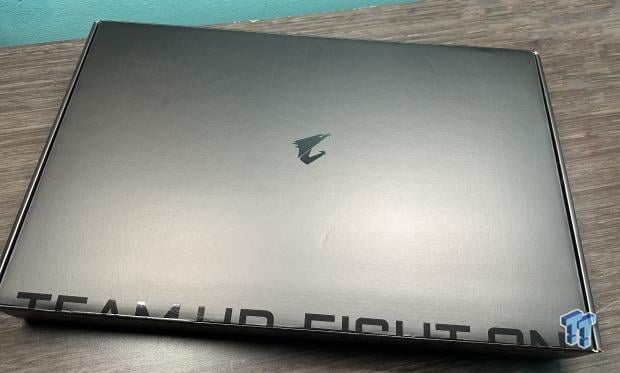
VIEW GALLERY – 31 IMAGES
The 17X was delivered in retail packaging, complete with AORUS branding.
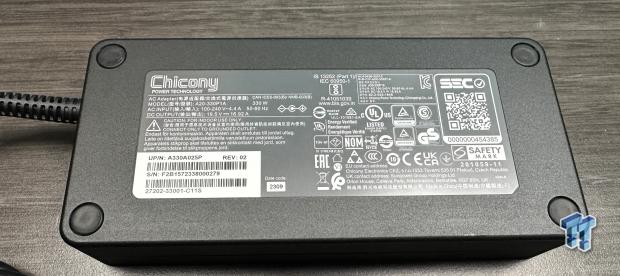
Chicony makes the power adapter at 330W.
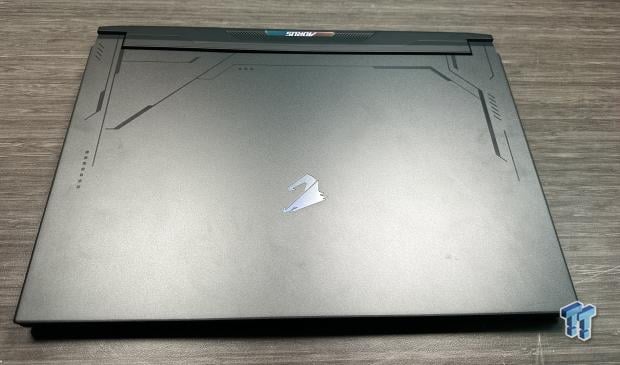
Unboxing, the 17X is deep metallic grey, with the AORUS logo on the lid.

The left side of the machine offers us two USB 3.2 along with a 3.5mm jack.

The right side pairs out the Thunderbolt 4 port and another USB 3.2.
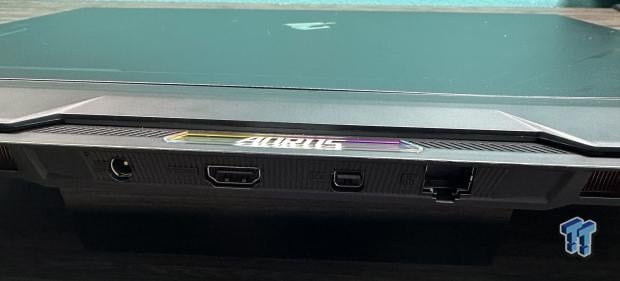
Rear I/O is typically found only on larger laptops like the 17X. This unit includes the power input, HDMI, MiniDP, and 2.5Gbe.
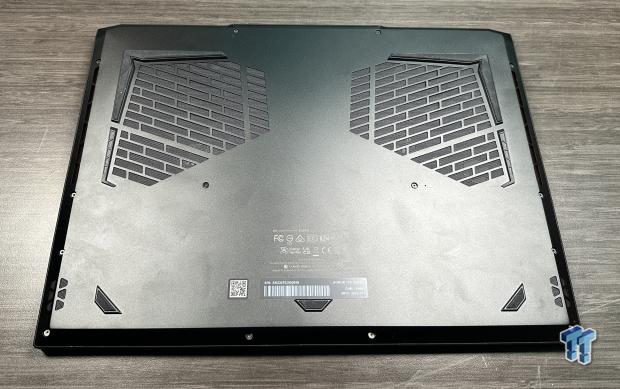
The bottom of the unit features large vents for pulling air into the unit, while rubber feet keep the unit off your desktop.
Keyboard & Trackpad
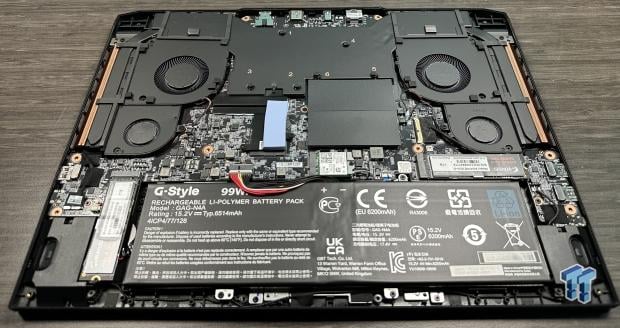
Opening up the 17X, we first touched on the trackpad, which we found to be quite small for the size of the chassis. It is an offset unit as well, which isn’t really our cup of tea, but it does offer solid feedback in use and is one of the smoothest offerings we have used due to its glass surface, which AORUS has patented. The keyboard is a full-size offering, complete with RGB; Solid feel in the keys with an excellent tactile click, though perhaps not as stiff as a keyboard like the Razer Blade.
Display
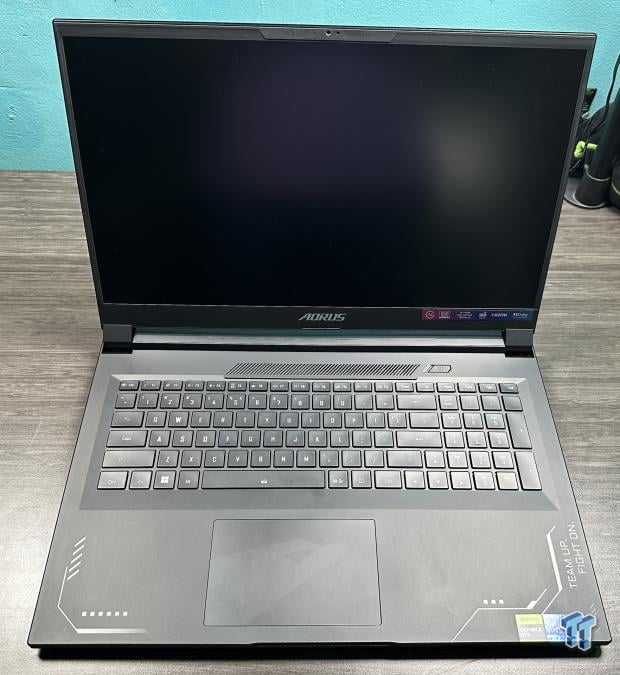
The display on this model is a 17″ 2560x1440p offering; it supports many of the latest technologies, including Dolby Vision and NVIDIA Gsync, with additional DCI-P3 certification. The refresh rate peaks at 240Hz, offering smooth visuals. The color on this panel is quite good, a touch better than the M18R2 if I’m honest; blacks are still slightly muted, though nothing distracts. We did note some backlight bleed while in a dark room, but only on the very edge.
Cooling

Opening up the bottom of the unit, we have the battery taking up the bottom half of the chassis with a massive 99Wh solution. Above that, we have room for dual Gen4 NVMe flanking on either side, Wi-Fi gets slotted between, and memory is tucked up next to the cooling. Cooling takes up the top half of the chassis; GIGABYTE calls this solution Windforce Infinity, featuring a complete cover vapor chamber design with copper five heat pipes and low turbulence fans, offering a more efficient cooling system with less noise, something we truly enjoyed when testing.
Upgradability
The 17X is mostly upgradable, but the M.2 Wi-Fi slot being CNVIO does present additional challenges because of the interface; the BE201 from Intel would be the likeliest upgrade here, so there is certainly hope as they do appear to be coming into the market as of this writing. Memory is quite good out of the box, with 32GB at 5600MHz, and both NVMe drives are identical, so those wanting to play around with Intel VMD could potentially pair them together for quicker storage, as the drives alone would be one thing we would upgrade if left as is.
BIOS/UEFI
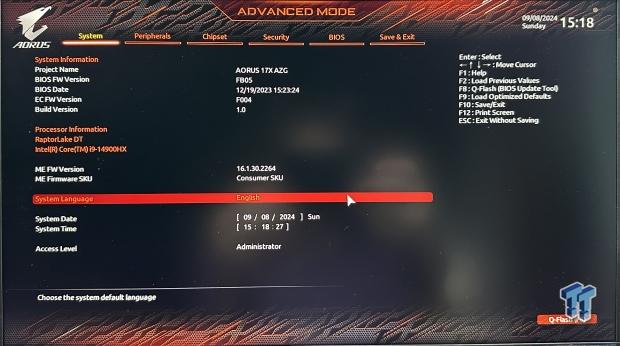
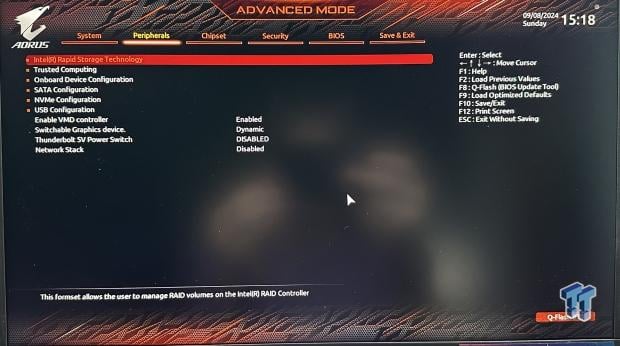
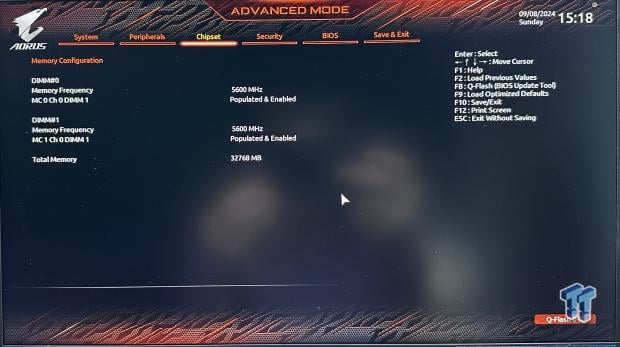
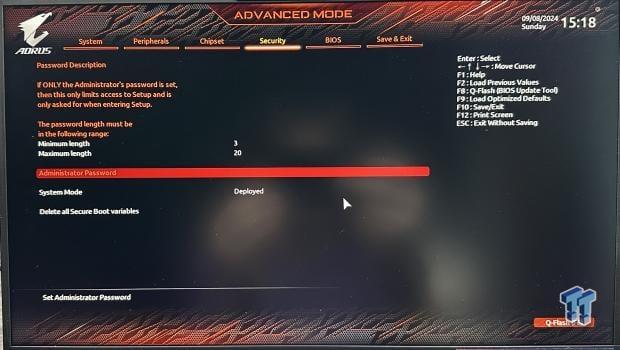
The 17X EFI is identical to what we find on AORUS Motherboard offerings; this offers an advanced mode, and the system page offers hardware information, including the BIOS version. Peripherals give access to Intel RST for VMD access. There’s also the onboard device config for your USB and other onboard devices, followed by SATA and NVMe. Further down, we have controls for switching the GPU device between the Intel iGPU and RTX 4000 solution.
Software
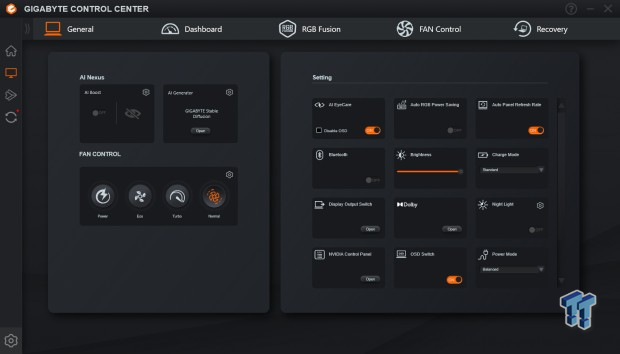
Performance can be tuned through the GIGABYTE Control Center. This gives consumers access to GIGABYTE’s AI Nexus suite for tuning the system’s performance, the general page offering fan control, and additional settings off to the right.
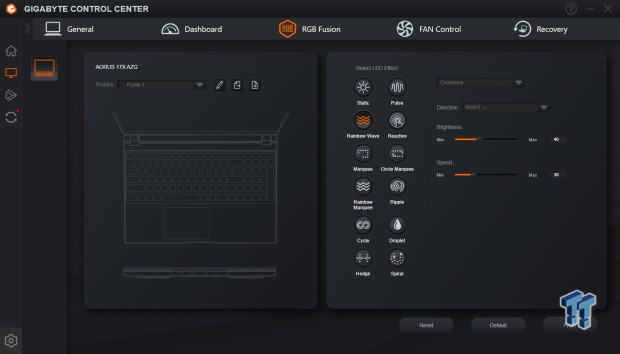
RGB Fusion allows control of the RGB on the keyboard, which includes preset modes and the option to make profiles.
System & CPU Performance
Cinebench
Cinebench is a long-standing render benchmark that Intel and AMD have relied on to highlight their newest platforms during unveilings. The benchmark has two tests: a single-core workload that utilizes one thread or 1T and a multi-threaded test that uses all threads or nT of a tested CPU.
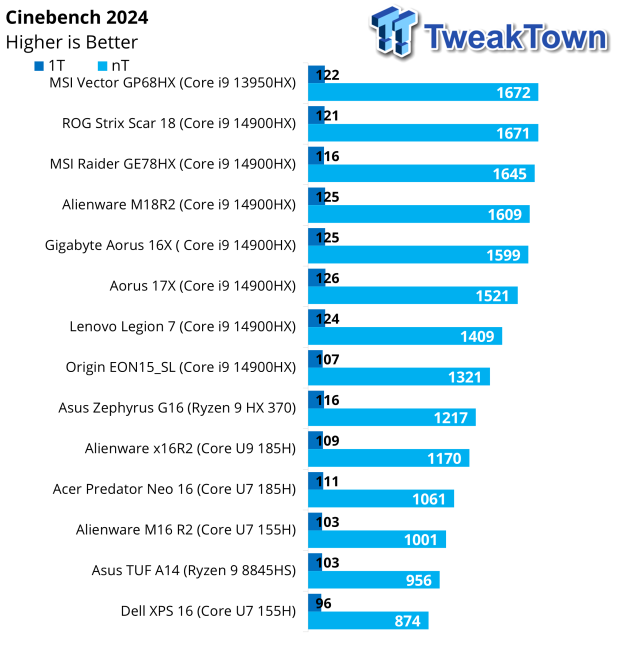
In Cinebench 2024, the 17X demonstrated solid performance. It scored 126 points in single-core performance, placing it in the top half of the tested systems. The multi-thread performance was also impressive, reaching 1521.
BAPCo CrossMark
CrossMark is an easy-to-run native cross-platform benchmark that uses real-world application models to measure overall system performance and responsiveness. CrossMark supports devices running Windows, iOS, and macOS platforms.
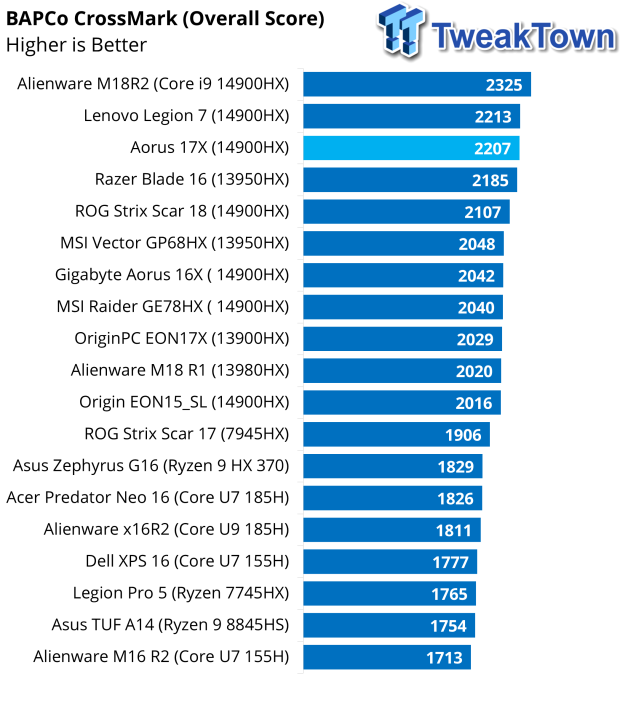
CrossMark picked up 2207 overall, putting the 17X top three in our charts.
AIDA64 Memory
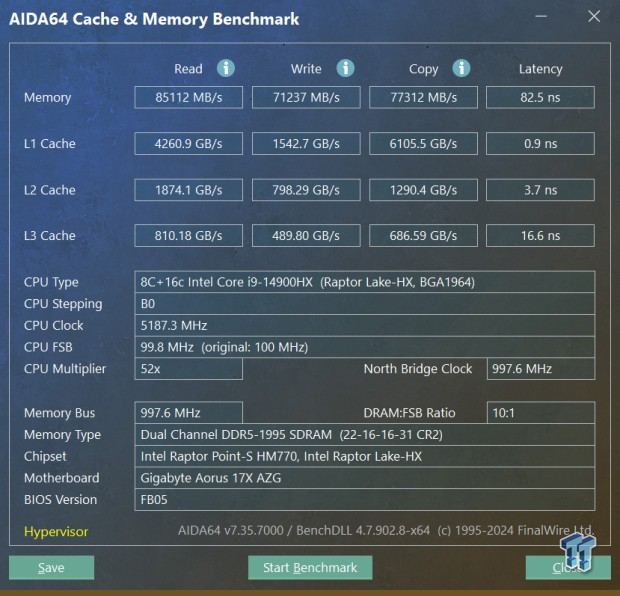
Memory performance was 85K read, 71K write, and 77K copy. Latency was 83 ns.
Geekbench 6
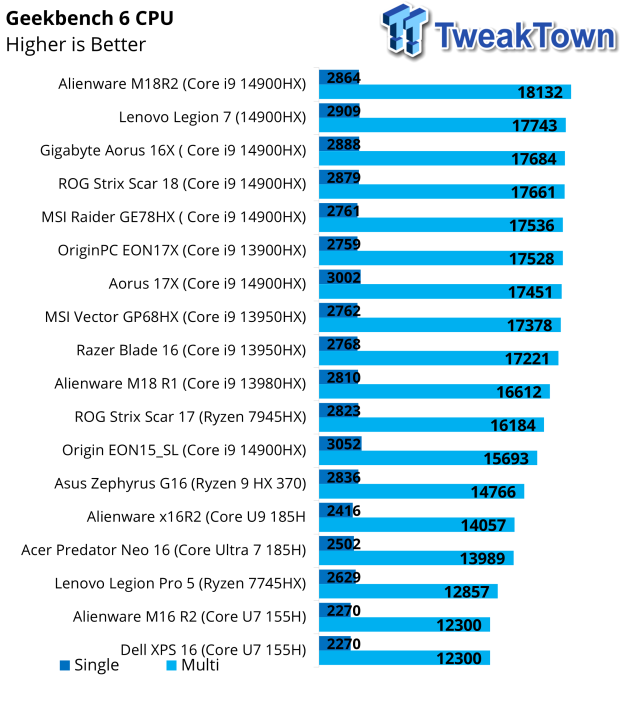
Geekbench scored 3002 in single-core workloads and 17451 in multi-core.
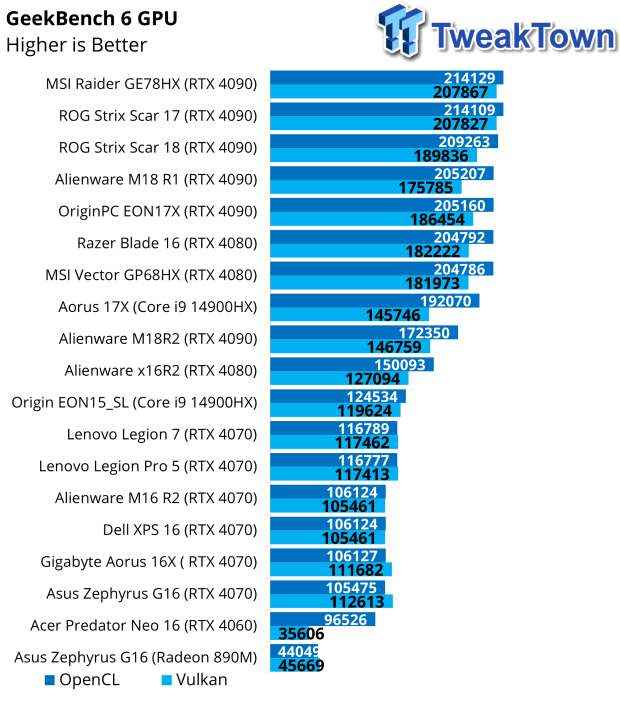
The AORUS picked up 192070K in OpenCL and 145756K in Vulkan.
Graphics & System I/O Performance
PCMark
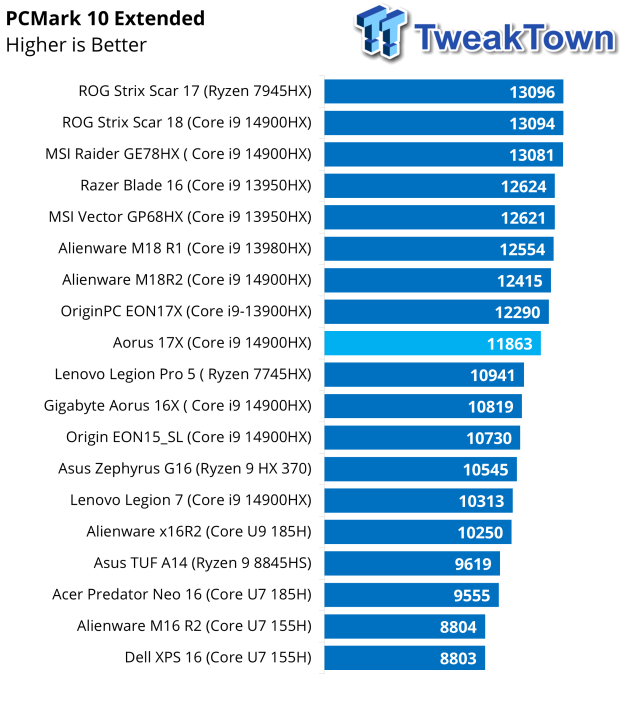
PCMark Extended landed at 11863, the middle of the pack of all gaming laptops tested.
3DMark
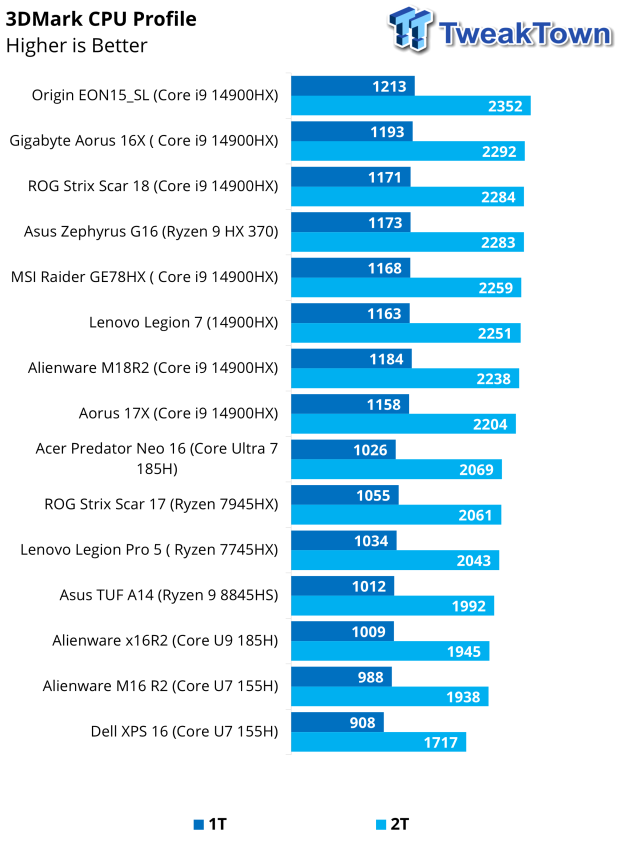
The CPU Profile for one and two cores has our 17X in the seventh spot in our charts, with scores of 1158 and 2204, respectively.
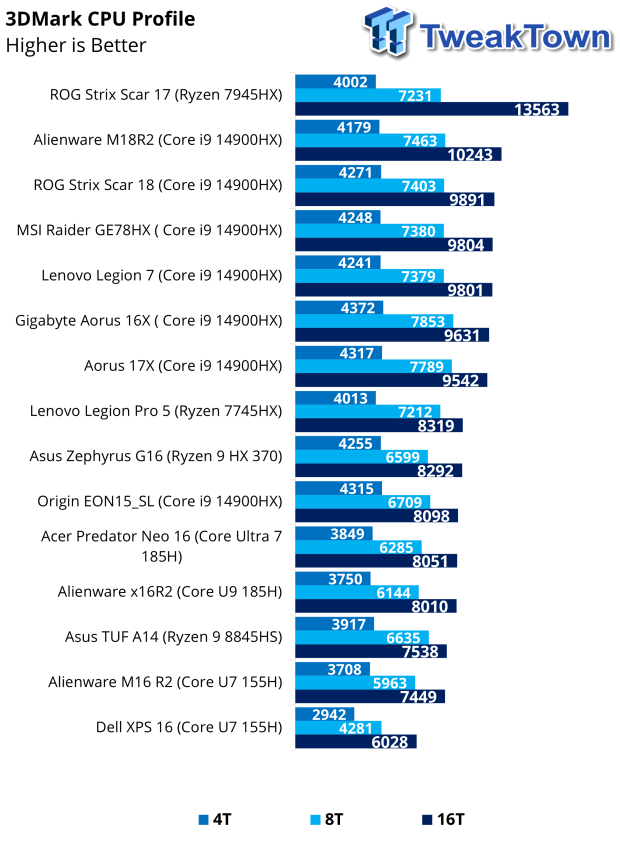
Increasing the core counts to four, eight, and sixteen, we pick up 4317 at four threads and 7789 at eight. We finish with a score of 9542 at sixteen threads, just shy of the AORUS 16X.
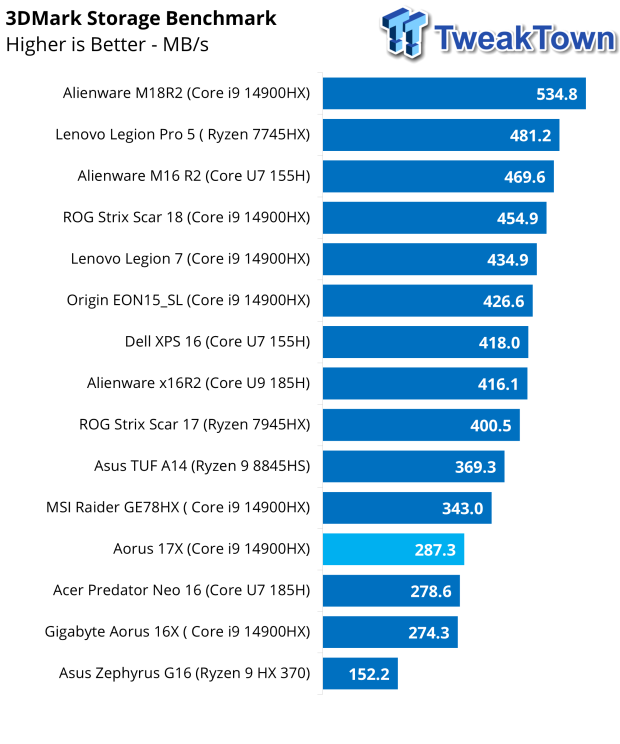
Storage landed at the bottom of the charts for the 17X at 287MB/s throughput.
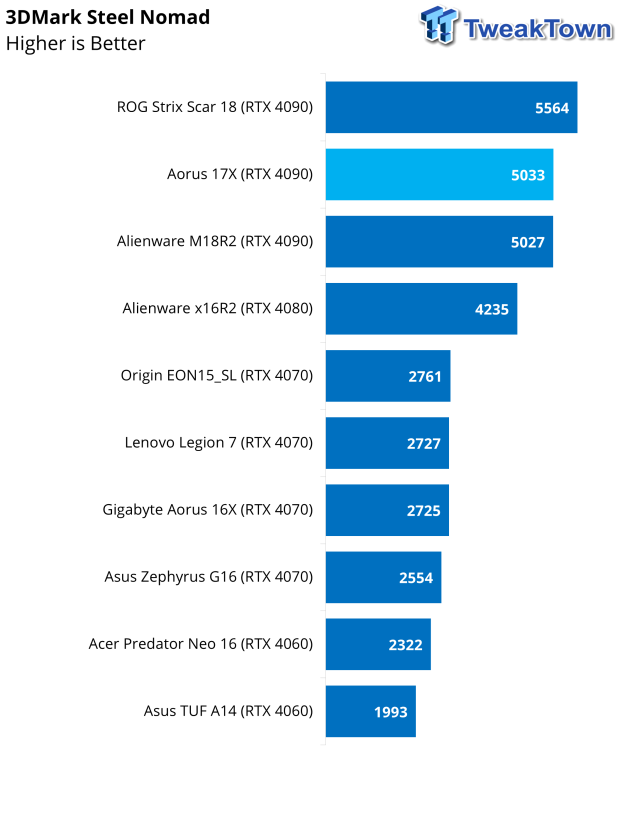
Pushing into gaming benchmarks, Steel Nomad landed at 5033 overall, second to the Scar 18.
Gaming Performance
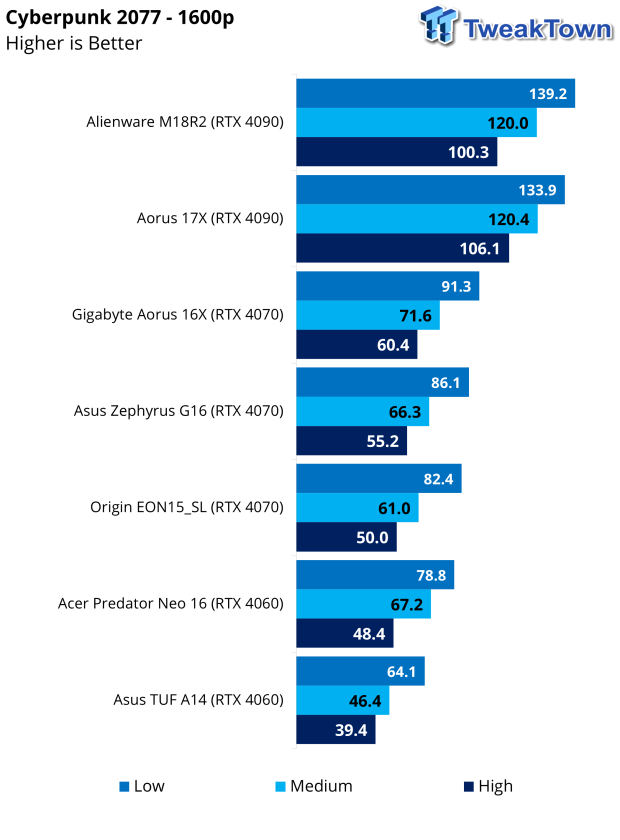
In Cyberpunk 2077, the 17X scored a solid 133 FPS with the low preset, followed by 120 FPS at medium settings and 106 FPS with the high preset.
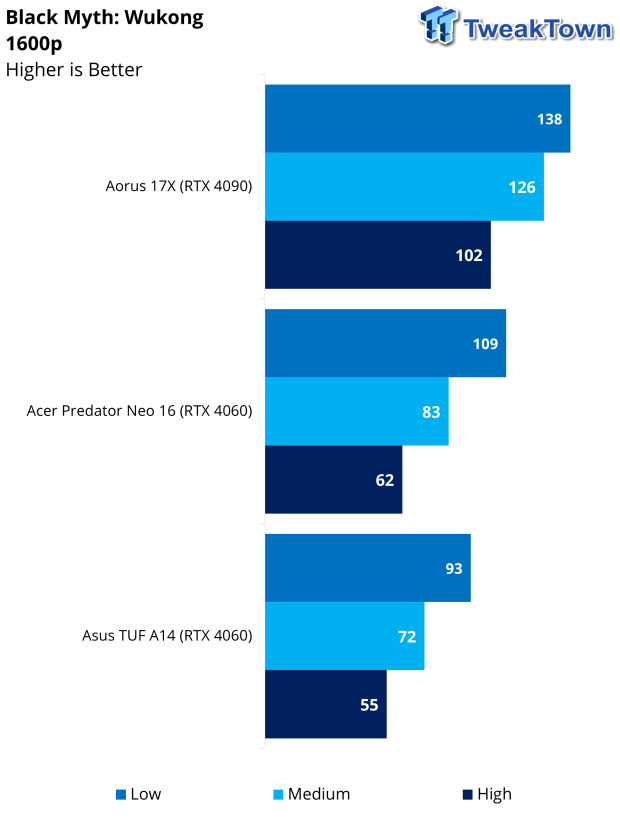
We added Black Myth: Wukong to make the charts more modern. With that, we pushed some solid performance with the AORUS 17X, grabbing 138 FPS with the low preset at 1600p, followed by 126 FPS at medium and 102 FPS on high.
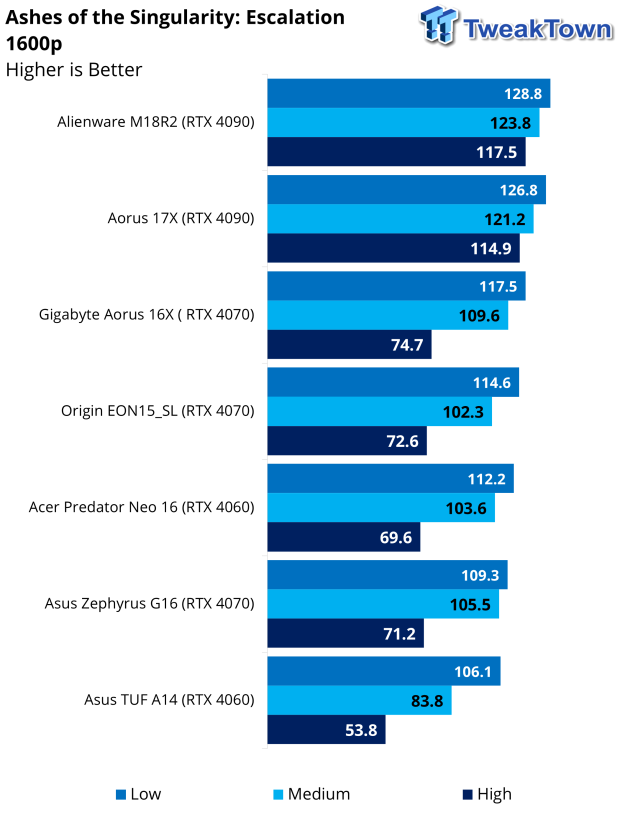
With the low preset, Ashes gave us 126 FPS to get us started. Moving the preset to high caused a small drop to 121 FPS, while the Crazy preset dropped us again slightly to 114 FPS.
Battery Life
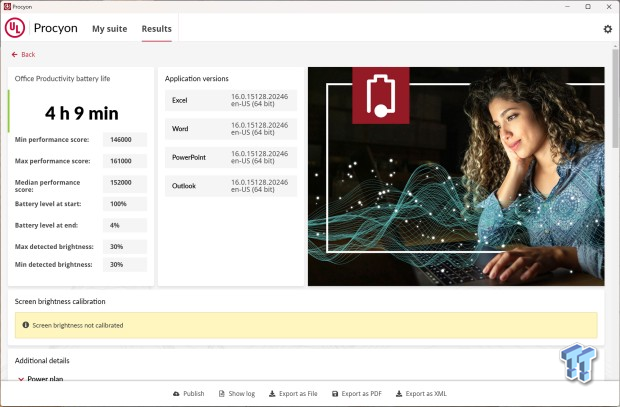
We have added legitimate battery testing to our gaming reviews because many use these systems as hybrid workhorses. That said, testing the AORUS 17X under the Procyon Office Productivity Suite, we landed a touch over four hours of battery life.
Final Thoughts
After reviewing the AORUS 16X, we were excited to receive the 17X. The 17X is a significant upgrade in terms of hardware, featuring a powerful 14900HX/RTX 4090 build that fits perfectly into the desktop replacement/monster category. However, it comes with a hefty price tag. The 17X boasts top-notch build quality with a sturdy frame and a metallic aesthetic. It has a good selection of ports, including three USB 3.2 and Thunderbolt 4, and a rare 2.5Gbe wired connection, a plus for stationary systems. While WiFi6e is a positive feature, it would have been great to have WiFi7, but hopefully, this is something that can be upgraded in the future.
Like the M18R2, the 17X offers top-notch performance across the board. Starting with Cinebench 2024, single-core performance reaches over 3000 points, only the second system to do so in our testing. This is followed by a solid single-core performance in Geekbench and CPU Profiles. Full system benchmarks were split. Crossmark scored top-three for the 17X at 2207, while PCMark landed this system middle of the pack.
Gaming was good on the 17X. We picked up solid numbers for Steel Nomad at 5033. Cyberpunk, Black Myth, and Ashes all performed without issue for our real-world benchmarks. Cyberpunk peaked at 133 FPS using the low preset, while the high preset wrapped at 106 FPS. Black Myth had no problems pulling 138 FPS, with the low preset dropping just a few FPS when we upped the quality to the high preset, ending our testing at 102 FPS. Ashes of Singularity gave us 126 FPS for the low preset, and cranking it up to the Crazy preset dropped us just 12 FPS to 114 overall.
As for pricing, the 17X will certainly take your arm, leg, and wallet with its $3589 MSRP. That said, the market is pretty competitive in this segment. Competing solutions include the MSI Raider GE78HX, which we recently reviewed. It has a nearly identical build and comes in at the same cost, while the M18R2, another system we just reviewed with similar specs, shares the same price as well.
Overall, the value of this system will come down to what connectivity options you need and your personal preference for design because they all offer desktop replacement performance with ease.



